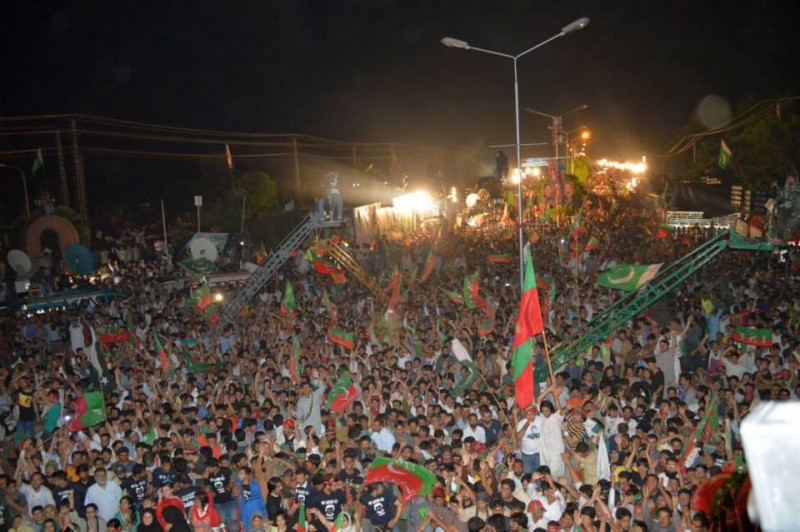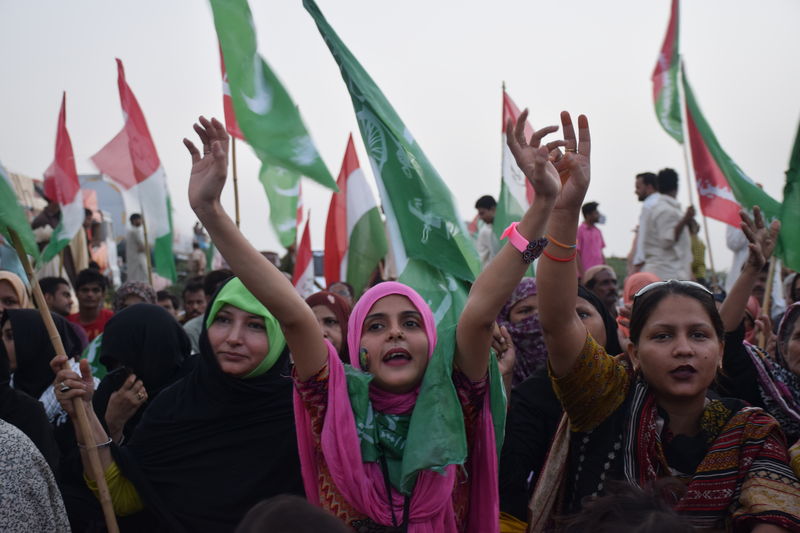
PTI protesters at the Aabpara Chowk in Islamabad on 16 Aug. 2014. Photo by Asadwarraich. CC BY-SA 4.0
Following days of protests, tens of thousands of anti-government demonstrators led by two populist politicians, Imran Khan and Dr. Tahirul Qadri, peacefully breached the capital of Pakistan's no-go ‘red zone’ manned by thousands of police and paramilitary troops.
Protesters were seen handing flowers to police and military security, who have orders to show restraint while handling protesters.
Usually, only people with security clearance are able to enter Islamabad's red zone, which is a designated high security area around the country's key government buildings including the prime minister's secretariat.
On Aug. 19, protesters removed shipping containers barricading the red zone, which also houses foreign embassies in its diplomatic enclave; both parties have vouched not to violate it.
Popular cricketer-turned-politician Imran Khan leads the party Pakistan Tehrik-e-Insaaf (PTI) and Pakistan Awami Tehreek (PAT) is led by a Pakistani-Canadian Sufi scholar-turned-politician Tahirul Qadri. Both allege that the May 2013 general election, which brought current Prime Minister Nawaz Sharif's party to power in a landslide victory, was rigged. They are marching to the capital to demand that he step down.
Initially, the government led by Sharif's party PML-N took extraordinary measures to prevent the two opposition parties from launching their massive anti-government marches to the capital, some 300 kilometers from Lahore city, on Pakistan's independence day Aug. 14.
In the first days of the protests, the crowds were at a few thousand, but they have since swelled to almost 100,000, according to some estimates.
Authorities attempts to place more containers to block off the area hasn't stopped the flow of protesters. Police were reportedly allowing most people to enter the area and only “half-heartedly” checking vehicles.
Inqilab March – 21st August Night Photos #RevolutionWithDrQadri #Pakistan #AwamiParliament pic.twitter.com/dp3bXZS2qg
— Ch Farakh Shahzad (@ChFarakh1) August 20, 2014
PAT and PTI activists may have jointly breached the red zone, but they are fundamentally two different parties. Shyema Sajjid writes in a blog on newspaper Dawn:
The PTI has once again done what no other political party could do (without threatening or buying them out): charge the previously apolitical and get them to rally for a cause, which quite possibly could rid us of a very corrupt government.
The PTI are disciplined enough to follow their leader Imran Khan’s call for peaceful protest but rowdy enough to flip a container or two without really causing harm to public property (leave aside the fact that they’ve taken over the capital city at the moment).
Alongside the PTI, march the angry man PAT’s Tahir-ul-Qadri and his chanters. His followers are very different from Khan’s supporters.
They will sit when he tells them to sit and stand when he wants them to rise. While Khan’s protest revolves around rigging and corruption the PML-N’s involved in, Qadri’s beef goes beyond.
Two months ago, several followers of TuQ lost their lives in a scuffle with the police outside his residence in Lahore. Those killed included women and children. The tragic incident was strongly protested against and in any other country, it would have been reason enough for members of the provincial if not federal, government to step down.
The difference was evident in each leader's statements. Khan tweeted defiantly:
“When injustice becomes law, resistance becomes duty.” Yesterday we took a giant step 4 Naya Pakistan & democracy..
— Imran Khan (@ImranKhanPTI) August 20, 2014
While Dr. Tahir-ul-Qadri demanded power for himself, reported Murtuza Ali Shah, a London reporter for several Pakistani news outlets:
Dr Tahir-ul-Qadri says he will not allow Pakistani PM come out alive from the parliament if he doesnt resign and hand over power to him — Murtaza Ali Shah (@MurtazaGeoNews) August 20, 2014

Supporters at Hyderabad Bypass, Hyderabad, Pakistan, stage a sit-in in support of Islamabad's “inqalab” (revolution) sit-in. Image by Rajput Yasir. Copyright Demotix (19/8/2014)
Military breaks silence
Meanwhile, the army, Pakistan's strongest institution, finally broke its silence on the protests. The military, which has ruled Pakistan for half its life, has increasingly been trying to distance itself from politics since General Musharraf stepped down as president in 2008.
After protesters breached the red zone, the army asked for talks between the government and the protesters of both parties. The committee formed by the government met the leadership of PTI, which made six demands, the first being the resignation of the prime minister. Talks broke down on Thursday.
Amidst this deadlock, some feared that a military coup may happen. Based on a comparative study of the three major coups of Pakistan history, Tahir Mehdi at Dawn opined that there is no possibility for a coup-de-tat.
Senior journalist Hamid Mir pointed out the essence of democracy present in protests:
Like it or not but this is the difference between democracy and dictatorship Musharraf never allowed public protest in front of parliament — Hamid Mir (@HamidMirGEO) August 20, 2014
Media pushes a revolution
The “I broke the news first” media culture has been seen in full effect throughout the coverage of the protests by local news channels in Pakistan. Outlets have often focused on what could happen rather than what is happening.
Adnan Rehmat, a media and political analyst, argued for Dawn that the media coverage given to the two political leaders behind the protest was disproportionate:
“Qadri may have hundreds of thousands of followers but his party is not an electoral stakeholder, so the disproportionately high media coverage of his demands on this subject seems unjust,” he says, adding: “Coverage of Imran’s grievance on this subject is more understandable, but considering that his party garnered only a little above 20% of the 2013 vote, the media is being dubious in granting him so much coverage while letting the views and narratives of 75% voters of other parties on the subject unrepresented.”
In newspaper The Express Tribune, Chris Cork said the media hype was distorting the reality of the protests:
Viewing the media over the last week, particularly the electronic media, it would not be difficult to convince oneself that Pakistan is gripped by revolutionary fervour. It is not. Something less than 60,000 people are currently camped on Constitution Avenue with who-knows-what in mind beyond a set of increasingly unlikely demands from their leaders. That is not a revolution. It is undoubtedly an expression of discontent, and the protesters may be voicing what many think or feel, but a revolution it aint.
Meanwhile, another PTI protest began at the historic Teen Talwar monument in the city of Karachi.
Protesters have camped out in the capital for nearly a week. With mounting pressure from local traders suffering economically due to the besieging of the capital as well as the residents of Islamabad stuck in increasing traffic jams due to route blockages, the government has to find a solution soon to avoid total chaos.







6 comments